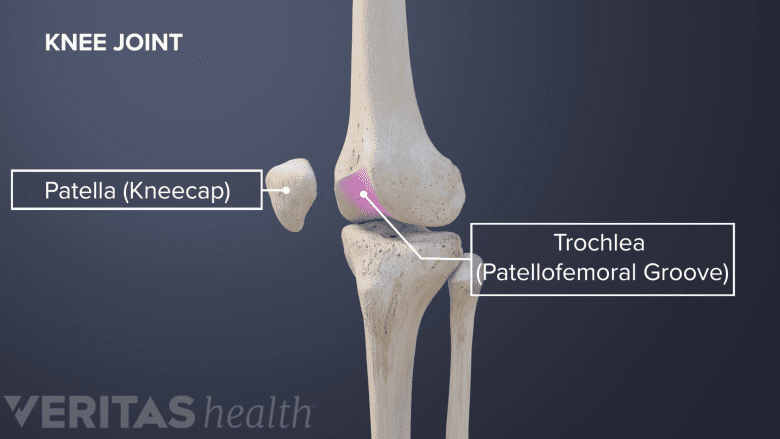The hallmark symptom of runner’s knee is pain in the front of the knee – around or behind the kneecap, particularly during movement such as running or squatting, or with prolonged sitting.
Runner’s knee pain is commonly felt behind the knee cap and increases when the knee is bent.
In This Article:
- What You Need to Know About Runner’s Knee
- Symptoms of Runner’s Knee
- Runner’s Knee Causes and Diagnosis
- Treatment of Runner’s Knee
This guide provides in-depth explanations of the causes, symptoms, and treatments of anterior (front) knee pain from runner’s knee.
What Is Runner’s Knee?
The knee pain starts gradually and tends to get worse over time.
- It is called runner’s knee because it is the most common running-related injury.1Esculier JF, Maggs K, Maggs E, Dubois B. A Contemporary Approach to Patellofemoral Pain in Runners. J Athl Train. 2020;55(12):0. doi:10.4085/1062-6050-0535.19
- The medical term for runner’s knee is patellofemoral pain syndrome because the patellofemoral joint is affected.
- The patellofemoral joint is in the front of the knee and connects the patella (kneecap) to the femur (thighbone).
- It can occur in one or both knees.
- Other medical terms related to runner’s knee are retropatellar pain syndrome, lateral facet compression syndrome, and idiopathic anterior knee pain.
See How Knee Joint Problems Cause Pain
Development of patellofemoral pain is not limited to runners and joggers; any activity that results in overuse of the front of the knee can lead to this type of knee pain – such as biking, doing squats, hiking, mountain climbing, and going up and down stairs.2InformedHealth.org [Internet]. Cologne, Germany: Institute for Quality and Efficiency in Health Care (IQWiG); 2006-. Overview: Patellofemoral pain syndrome (runner’s knee) [Updated 2024 Jan 30]. Available from: https://www.ncbi.nlm.nih.gov/books/NBK561507/
Anatomy and Abnormal Movement of the Kneecap
When the knee bends and straightens, the inner surface of the kneecap (patella) glides along a groove at the end of the thigh bone (femur) called the patellofemoral groove (or trochlea).
Runner’s knee develops when the kneecap does not glide or “track” accurately within this groove, causing increased stress at the front of the knee joint.
Abnormal tracking of the kneecap is more common laterally – where the kneecap shifts toward the outer side of the knee.
How Patellofemoral Pain Syndrome Develops

Overuse of the quadriceps and patellar tendons is known to cause patellofemoral pain syndrome.
The condition develops due to overuse of the knee and/or weak muscles and tendons around the kneecap – especially the quadriceps and patellar tendons, which hold the kneecap in its floating position in front of the thigh bone.
Less commonly, trauma or changes in the biomechanics of the leg or foot contribute to kneecap pain.
The Course of Patellofemoral Pain Syndrome
This type of kneecap pain typically progresses as follows:
- In the initial stages, patellofemoral pain occurs while bending and bearing weight on the knee, such as while climbing or descending stairs or squatting.
- Pain improves with rest, activity modification, and/or non-surgical treatment.
- Pain tends to return once physical activity is resumed or when the knee is overused.
- If left untreated, the pain becomes constant, with activity-related flare-ups of increased pain.
Over time, the cartilage that lines the joint surfaces of the kneecap and the thigh bone tends to wear out, increasing the risk for conditions such as knee osteoarthritis.3Bump JM, Lewis L. Patellofemoral Syndrome. [Updated 2023 Feb 13]. In: StatPearls [Internet]. Treasure Island (FL): StatPearls Publishing; 2024 Jan-. Available from: https://www.ncbi.nlm.nih.gov/books/NBK557657/
How treatment affects runner’s knee pain
Most people with patellofemoral pain find relief through non-surgical treatments, but around 40% of people may continue to have chronic symptoms that last over a year.2InformedHealth.org [Internet]. Cologne, Germany: Institute for Quality and Efficiency in Health Care (IQWiG); 2006-. Overview: Patellofemoral pain syndrome (runner’s knee) [Updated 2024 Jan 30]. Available from: https://www.ncbi.nlm.nih.gov/books/NBK561507/
Some of the common treatments for runner’s knee include activity modification, pain-relieving medication, and physical therapy.2InformedHealth.org [Internet]. Cologne, Germany: Institute for Quality and Efficiency in Health Care (IQWiG); 2006-. Overview: Patellofemoral pain syndrome (runner’s knee) [Updated 2024 Jan 30]. Available from: https://www.ncbi.nlm.nih.gov/books/NBK561507/,4Leibbrandt DC, Louw QA. Patients' perceptions of recovery following a 6-week exercise intervention for the treatment of patellofemoral pain: A mixed methods study. S Afr J Physiother. 2019;75(1):684. Published 2019 Jul 25. doi:10.4102/sajp.v75i1.684 Physical therapy and rehabilitation programs are an essential component of kneecap pain treatment and focus on strengthening the muscles around the knee joint, improving flexibility, and correcting any biomechanical imbalances that contribute to the pain.
Even if the symptoms of runner's knee don’t completely resolve, continuing physical therapy is useful in reducing pain intensity and increasing knee range of motion, allowing individuals to participate in daily activities.3Bump JM, Lewis L. Patellofemoral Syndrome. [Updated 2023 Feb 13]. In: StatPearls [Internet]. Treasure Island (FL): StatPearls Publishing; 2024 Jan-. Available from: https://www.ncbi.nlm.nih.gov/books/NBK557657/
In rare cases, surgery is considered if non-surgical treatments fail to relieve symptoms for at least 2 years.2InformedHealth.org [Internet]. Cologne, Germany: Institute for Quality and Efficiency in Health Care (IQWiG); 2006-. Overview: Patellofemoral pain syndrome (runner’s knee) [Updated 2024 Jan 30]. Available from: https://www.ncbi.nlm.nih.gov/books/NBK561507/
Poor treatment outcomes are generally seen when there are symptoms in both knees, a hypermobile patella (kneecap that glides faster than usual), and/or advanced age.
Knee Pain that Mimics Runner’s Knee
Patellofemoral pain syndrome shares a common set of symptoms with several other knee conditions:
- Chondromalacia patellae occurs when the cartilage underneath the kneecap softens and deteriorates, leading to knee pain and discomfort.
Runner’s knee and chondromalacia patellae share similar symptoms, such as pain around the kneecap during activities that stress the knee joint. Previously, these conditions were believed to be the same, but they are now recognized as separate knee conditions. - Jumper’s knee or patellar tendinopathy, where the patellar tendon at the bottom of the kneecap becomes inflamed or injured. See Jumper's Knee vs. Runner's Knee
Jumper’s knee pain is felt under the kneecap and tends to reduce with activity as the tendon “warms up” with knee movement. - Quadriceps tendinopathy, where the quadriceps tendon above the kneecap becomes inflamed or injured.
Quadriceps tendinopathy pain is felt above the kneecap and tends to worsen with activities that stress the knee joint. - Meniscal tears occur when medial or lateral menisci (flexible cartilage situated between the knee bones) tear or degenerate.
Meniscal tear pain worsens with knee movement and is associated with a popping sound. - Iliotibial (IT) band syndrome is a condition where the IT band (a strip of soft tissue that runs down the outer thigh and ends just below the knee) is tight and rubs against the thigh bone during knee movements.
IT band pain is felt on the outer side of the knee and peaks when the knee bends at 30°.5Pegrum J, Self A, Hall N. Iliotibial band syndrome. BMJ.2019;364:l980. doi:10.1136/bmj.l980, 6Fairclough J, Hayashi K, Toumi H, et al. The functional anatomy of the iliotibial band during flexion and extension of the knee: implications for understanding iliotibial band syndrome. J Anat. 2006;208(3):309-316. doi:10.1111/j.1469-7580.2006.00531.x - Knee osteoarthritis occurs when the cartilage lining the bony surfaces of the knee joint degenerates and causes friction and inflammation in the knee.
Knee arthritis pain worsens with activities that stress the joint, such as squatting or climbing stairs.
It is possible for these conditions to coexist with runner’s knee.
Runner’s knee is diagnosed and treated by a number of specialists trained in physical medicine, such as physiatrists, sports medicine specialists, physical therapists, chiropractors, and orthopedic surgeons.
When Kneecap Pain Is Serious
While knee pain is a common complaint, certain red flags might indicate a more serious underlying condition, such as a joint infection or tumor, warranting urgent medical attention. These symptoms include but are not limited to:
- Severe pain in the knee(s) that interferes with daily activities
- Increased night-time pain
- Swelling around the knee (water on the knee)
- Redness, irritation, and/or warmth around the knee
- Stiffness in the knee joint
Knee pain that starts after trauma or knee pain with fever or unexplained weight loss also warrants prompt medical evaluation.
- 1 Esculier JF, Maggs K, Maggs E, Dubois B. A Contemporary Approach to Patellofemoral Pain in Runners. J Athl Train. 2020;55(12):0. doi:10.4085/1062-6050-0535.19
- 2 InformedHealth.org [Internet]. Cologne, Germany: Institute for Quality and Efficiency in Health Care (IQWiG); 2006-. Overview: Patellofemoral pain syndrome (runner’s knee) [Updated 2024 Jan 30]. Available from: https://www.ncbi.nlm.nih.gov/books/NBK561507/
- 3 Bump JM, Lewis L. Patellofemoral Syndrome. [Updated 2023 Feb 13]. In: StatPearls [Internet]. Treasure Island (FL): StatPearls Publishing; 2024 Jan-. Available from: https://www.ncbi.nlm.nih.gov/books/NBK557657/
- 4 Leibbrandt DC, Louw QA. Patients' perceptions of recovery following a 6-week exercise intervention for the treatment of patellofemoral pain: A mixed methods study. S Afr J Physiother. 2019;75(1):684. Published 2019 Jul 25. doi:10.4102/sajp.v75i1.684
- 5 Pegrum J, Self A, Hall N. Iliotibial band syndrome. BMJ.2019;364:l980. doi:10.1136/bmj.l980
- 6 Fairclough J, Hayashi K, Toumi H, et al. The functional anatomy of the iliotibial band during flexion and extension of the knee: implications for understanding iliotibial band syndrome. J Anat. 2006;208(3):309-316. doi:10.1111/j.1469-7580.2006.00531.x


